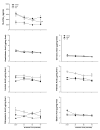Activation of peroxisome proliferator-activated receptor-gamma during hepatic ischemia is age-dependent
- PMID: 18498870
- PMCID: PMC2737330
- DOI: 10.1016/j.jss.2008.02.004
Activation of peroxisome proliferator-activated receptor-gamma during hepatic ischemia is age-dependent
Abstract
Hepatic ischemia/reperfusion injury is a complication of liver surgery, transplantation, and shock and is known to be age-dependent. Our laboratory has recently shown that peroxisome proliferator-activated receptor-gamma (PPARgamma) is down-regulated during hepatic ischemia and that this exacerbates injury. Here we examined whether activation of PPARgamma during ischemia was age-dependent. Male mice of different ages (young: 4-5 weeks; adult: 10-12 weeks; old: 10-12 months) were subjected to up to 90 min of hepatic ischemia. PPARgamma activation occurred throughout ischemia in young mice, whereas activation in adult and old mice was lost after 30 min. No significant differences were noted in PPARgamma ligand expression among the age groups. However, in young mice we observed a predominance of PPARgamma1 in the nucleus, whereas in old mice this isoform remained largely in the cytoplasm. Finally, the degree of PPARgamma activation was associated with autophagy in the liver, a mechanism of self-preservation. PPARgamma activation is prolonged in young mice as compared to older mice. This appears to be mediated by a selective retention of PPARgamma1 in the nucleus and is associated with increased autophagy. The data suggest that PPARgamma activation is an important component of the age-dependent response to hepatic ischemia/reperfusion injury.
Figures





References
-
- Lentsch AB, Kato A, Yoshidome H, McMasters KM, Edwards MJ. Inflammatory mechanisms and therapeutic strategies for warm hepatic ischemia/reperfusion injury. Hepatology. 2000;32:169–173. - PubMed
-
- Jaeschke H. Molecular mechanisms of hepatic ischemia-reperfusion injury and preconditioning. Am J Physiol Gastrointest Liver Physiol. 2003;284:G15–26. - PubMed
-
- Okaya T, Blanchard J, Schuster R, Kuboki S, Husted T, Caldwell CC, Zingarelli B, Wong H, Solomkin JS, Lentsch AB. Age-dependent responses to hepatic ischemia/reperfusion injury. Shock. 2005;24:421–427. - PubMed
-
- Calkins CM, Bensard DD, Moore EE, McIntyre RC, Silliman CC, Biffl W, Harken AH, Partrick DA, Offner PJ. The injured child is resistant to multiple organ failure: a different inflammatory response? J Trauma. 2002;53:1058–1063. - PubMed
Publication types
MeSH terms
Substances
Grants and funding
LinkOut - more resources
Full Text Sources

